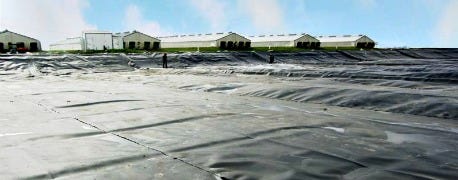August 19, 2014

Construction is underway in northern Missouri on an innovative $80 million renewable energy project, developed and constructed by Roeslein Alternative Energy, LLC (RAE) in collaboration with Murphy-Brown of Missouri, LLC (MBM) the livestock production subsidiary of Smithfield Foods, Inc.

POWER SOURCE: An innovative $80 million renewable energy project is underway in northern Missouri as Roeslein Alternative Energy uses hog manure to make renewable natural gas.
Crews are installing impermeable covers on 88 existing lagoons to harvest biogas, also called renewable natural gas from MBM hog finishing farms using best in class anaerobic digestion technology developed and installed by RAE. The project is the largest of its kind, utilizing manure from one of the biggest concentrations of finishing hogs in the Midwest to create several hundred million cubic feet of renewable natural gas annually for regional distribution.
The project is a unique and innovative model for sustainability that will demonstrate how underutilized agricultural resources can create renewable fuel, benefit the ecosystem and generate economic opportunity.
"We are excited to see the results of our collaboration with Smithfield and Murphy-Brown begin to take shape. This project can be a model to show how both economic and environmental benefits can be gained by using manure in a different way," said Rudi Roeslein, president of Roeslein Alternative Energy and CEO of Roeslein & Associates, a global leader in systems integration specializing in sophisticated modular construction.
Using anaerobic digestion for energy
Impermeable synthetic covers will be placed on existing nutrient treatment lagoons where barn scraper technology will deliver raw nutrients of livestock manure to covered lagoons. The covers turn the lagoons into anaerobic digesters, where naturally occurring microorganisms decompose the manure in an oxygen free environment. Biogas rises to the top where it will be collected and cleaned of impurities. What remains is more than 98 percent methane with approximately the same chemical composition as natural gas that can be used for vehicle fuel or injected into the natural gas grid system. The undigesteable solid residue can be used by local farmers as a natural fertilizer and the water can be safely used for irrigation.
"This project fits perfectly with our mission to not only to be responsible environmental stewards, but create a direct benefit to the community by helping create a product such as natural gas – a renewable, clean-burning fuel," said Bill Homann, director of administration for Murphy Brown Missouri. "Partnering with experts like Roeslein help us make projects like these a reality."
"There is value in the gas we capture as alternative vehicle fuel. There is even more value to the environment from reduced greenhouse gas emissions, eliminating rainfall effects on treatment systems, and odor reduction," Roeslein said.
Renewable energy production
High Density Polyethylene (HDPE) lagoon covers installed at MBM Valley View and South Meadows farms in Northern Missouri by fall 2014 is expected produce renewable natural gas by late 2014.
In addition to using hog manure, RAE ultimately intends to produce renewable natural gas from cover crops harvested between growing seasons on prime agriculture land and grasses harvested from highly erodible farm ground converted to native grasslands. The concept creates an economic structure that better utilizes land assets, delivers significant environmental benefits, reduces soil erosion, benefits wildlife and improves water quality.
Source: Roeslein
You May Also Like




